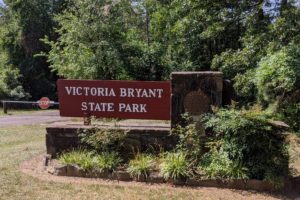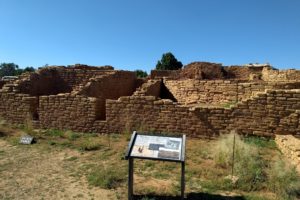As we looked at the state of North Dakota to plan this trip, we knew we wanted to see the northern part of Theodore Roosevelt National Park; the closest town of any size to this park and some historical sites we also wanted to see was Williston, so we found an RV park in town. We settled in for a few days so we could catch up on groceries, get much-needed haircuts, and see some history. What we didn’t expect to find was the beginning of the oil industry boom.

Williston is the largest of the cities in the northwest corner of North Dakota. In 2010, its population was 14,716; the Census Bureau’s estimated population in 2019 was 29,033, making it the sixth-largest city in North Dakota. The oil boom in this area is largely responsible for the sharp increase in population.
Williston is close to where the Yellowstone and Missouri Rivers meet. From here, the Missouri River continues southeast through North Dakota to eventually meet up with the Mississippi River.
When we look at the history of this part of ND in some future posts, we’ll fill you in on Williston’s history as a town, but ever since it was founded in 1887, it’s been the economic center of trading in the region. Over the past 10 years more than 2 billion dollars of new construction has provided housing and infrastructure to meet the needs of the growing city. As the population gets younger, the town is adding attractions that fit the lifestyle of young families moving to the area. An airport built in 2019 has helped the city grow as well.
We stayed at Buffalo Trails RV Park on the north side of town. It was really just a flat piece of land with hookups for trailers, but the owner was so helpful by connecting us with a chiropractor and a hair dresser!










an outing for juneberry pie
West of town about an hour away, a reservoir was built along the Missouri River to create Lake Sakakawea, named for the Native American woman who served as a guide for Lewis and Clark as they explored the Louisiana Purchase. At 368,000 acres, it’s the 3rd largest reservoir in the United States and has more shoreline than the whole state of California! We heard about Lund’s Landing on the lake as a place to go to for lunch.





(I grew up eating walleye pike that dad had caught when we’d spend his summer vacations in northern Minnesota camping at their parks and swatting mosquitoes.)

Juneberries
So what are Juneberries? The berries from this native fruit-bearing shrub are available in spring. The shrubs are found throughout the Northern Great Plains and northward through the Canadian prairie provinces into the Southern Yukon and Northwest Territories.
Explorers and fur trappers followed the Indians in harvesting and eating the wild Juenberries (that are also known as Serviceberries) long before ND was a state. Meriwether Lewis wrote in 1805 that his party depended partly on these berries in pancakes to keep from starving.
In the early years, the Torgersons hiked all over their property each spring in search of elusive Juneberries for their pies. Now fields of these shrubs are in the central part of the state, and berries are harvested as a crop. Analene buys them in bulk and freezes them so pies can be made year-round.
Juneberries favor the north slopes of hillsides and grow from knee to chest high. The berries are dark blue, and most are picked in late June before the July heat dries them up and the birds find them.
Many think that this large pea-sized Juneberry should be the state fruit instead of the chokeberry that we’ve seen in previous posts, but so far no changes to the state fruit choice. (We bought some chokeberry vinaigrette, and it’s delicious!)
Lund’s Landing magazine article
As we were ready to leave, I saw the following magazine article posted on the wall about where we are that’s “A Prairie Oasis.”

Jim and Analene Torgerson have owned this marina, lodge, and restaurant for more than 29 years. During the droughts in the 1980s and 1990s, they had to change their business plan by adding a restaurant to serve the locals and the oil workers working nearby. They now operate the largest private marina on Lake Sakakawea that houses nearly 50 boats and pontoons.

The resort offers rustic cabins, authentic tipis, and a campground for overnight stays, as well as kayaks, canoes, pontoons, and motorboats for days on the lake.

The evergreen trees that they planted 30 years ago are now more than 30 feet tall, and hundreds of flowers are in bloom. Now over 75 boat slips dot the waterfront.


As we were walking into the restaurant, we met a young couple eating outside with the husband’s father who was visiting from north central ND. The husband works in the oil industry and told us about a plaque in the area honoring the discovery of oil in North Dakota, so of course we set out to find this plaque.
discovery of oil in North Dakota



Drilling for oil is big business in northwest ND. You’ve probably heard about the Bakken Formation. It’s where we are right now around Williston. Do you know what’s involved in drilling for oil? We started our education on this topic when we were traveling along the Gulf Coast and saw information and museums about offshore oil rigs that you might want to check out in the 2019 Southwest Swing’s Gulf Coast’s posts.
In the next post we’ll take a closer look at what drilling for oil in North Dakota is all about.




